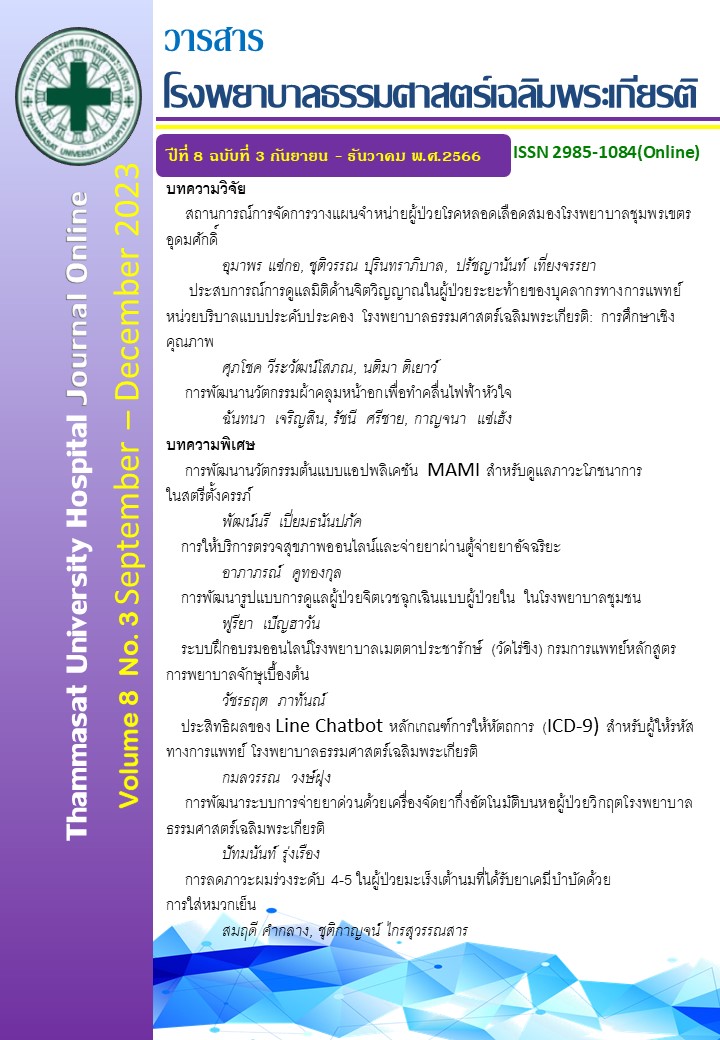The development of an inpatient acute care model for psychiatric patients in community hospital
Keywords:
Emergency psychiatry, Incidence of risks during, ReadmissionAbstract
Background: Due to the increasing number of psychiatric patients, we developed an inpatient acute care model to help ensure the effective patient caring in the inpatient ward.
Objective: To study the situation of psychiatric patients in Raman district Hospital in order to develop an inpatient acute care model for psychiatric patients and to study the effects of applying an inpatient acute care model for psychiatric patients in a community hospital.
Material and methods: This research was a research and development. There were 3 phases of the research: Phase 1: Studying the situation of psychiatric patients in Raman district Hospital and doing the focus group with registered nurses. Phase 2: Development of an inpatient acute care model for psychiatric patients Phase 3: Assessing the outcomes of an inpatient acute care model for psychiatric patients. The sample included 17 registered nurses who currently work in the male inpatient ward and 42 emergency psychiatric patients admitted in the male inpatient ward. The sample were selected specifically to study the outcomes of applying an inpatient acute care model for psychiatric patients.
Result: After applying an inpatient acute care model for psychiatric patients, there was no incidence of risk that occurred during an admission. The re-admission rate of an emergency psychiatric patients decreased. The experiment showed a significantly higher score of the inpatient acute care post-test done by registered nurses, compared to the pretest score. Registered nurses were satisfied with an inpatient acute care model for psychiatric patients at the high and highest level for 82.31%.
Conclusion: This inpatient acute care model for psychiatric patients is clear and uniformed for patient care. It enables the convenient communication about the information between care providers, therefore nurses can follow all guidelines. Patients receive comprehensive care from the access to the continuity of care.
References
สำนักงานพัฒนานโยบายสุขภาพระหว่าง ประเทศ. รายงานภาระโรคและการบาดเจ็บของประชากรไทย พ.ศ.2557. นนทบุรี: สำนักพิมพ์เดอะ กราฟิโก ซิสเต็มส์; 2560.
พรทิพย์ วชิรดิลก, ธีระ ศิริสมุด, อนุรัตน์ สมตน. ผู้ป่วยฉุกเฉินวิกฤตสุขภาพจิตที่เข้าถึงระบบบริการการแพทย์ฉุกเฉินในประเทศไทย. วารสารการพยาบาลจิตเวชและสุขภาพจิต. 2561;32(2):69-83.
กรมสุขภาพจิต. แนวทางการจัดตั้งหอผู้ป่วยจิตเวชและยาเสพติด สำหรับโรงพยาบาลศูนย์ โรงพยาบาลทั่วไป (ฉบับทดลองใช้ พ.ศ. 2564). นนทบุรี: กรมสุขภาพจิต กระทรวงสาธารณสุข; 2564.
กรมสุขภาพจิต. แนวทางการดูแลผู้ป่วยจิตเวชฉุกเฉิน (Acute Care) สำหรับหน่วยบริการสาธารณสุข (ระดับ A, S, M1 และ M2) ฉบับทดลองใช้. นนทบุรี : กรมสุขภาพจิต กระทรวงสาธารณสุข; 2563.
สถาบันพัฒนาและรับรองคุณภาพโรงพยาบาล. มาตรฐานโรงพยาบาลและบริการสุขภาพฉบับเฉลิมพระเกียรติฉลอง ศิริราชสมบัติครบ 60 ปี. พิมพ์ครั้งที่ 2. นนทบุรี: หนังสือดีวัน; 2554.
ธีระ ศิริสมุด, พรทิพย์ วชิรดิลก, อนุรัตน์ สมตน. การพัฒนารูปแบบระบบบริการการแพทย์ฉุกเฉินสำหรับผู้ป่วยฉุกเฉินวิกฤตสุขภาพจิตแบบบูรณาการในพื้นที่. วารสารวิชาการสาธารณสุข. 2562; 28(2):157-171.
ภัครินทร์ ชิดดี, สุจริต ทุมจันทร์, เพชรศรี สารรัตน์, อัชรา พิลาทอง, พิสมัย ทิพย์วารี, ดาราพร สิงห์ทอง. การพัฒนารูปแบบการดูแลผู้ป่วยจิตเวช โรงพยาบาลอำนาจเจริญ จังหวัดอำนาจเจริญ.วารสารวิชาการสาธารณสุข. 2563; 29(2):491-496.
จลี เจริญสรรพ. การพัฒนารูปแบบการดูแลผู้ป่วยโรคจิตเภทในโรงพยาบาลสวนสราญรมย์. วารสารการพยาบาลจิตเวชและสุขภาพจิต. 2558; 29(3):85-98.
Downloads
Published
How to Cite
Issue
Section
License
Copyright (c) 2023 Thammasat University Hospital Journal Online

This work is licensed under a Creative Commons Attribution-NonCommercial-NoDerivatives 4.0 International License.


